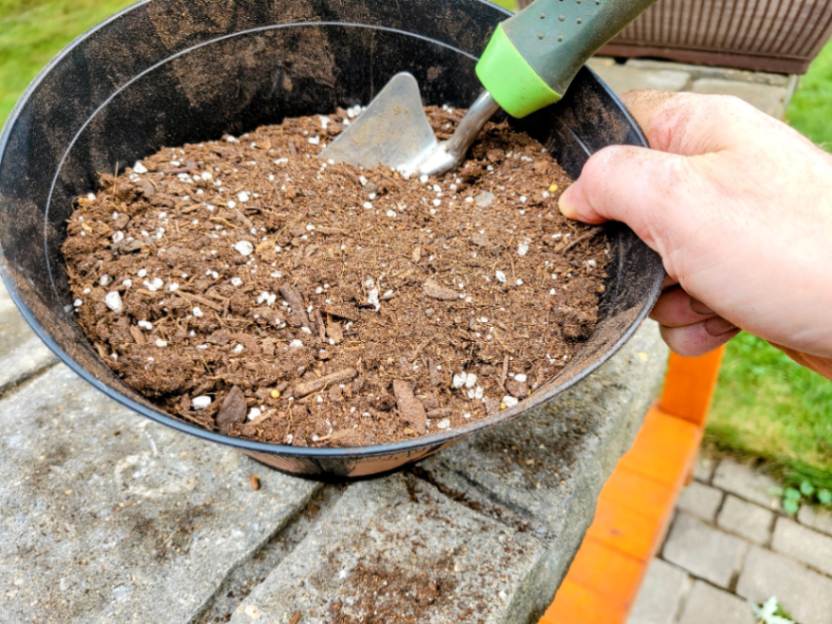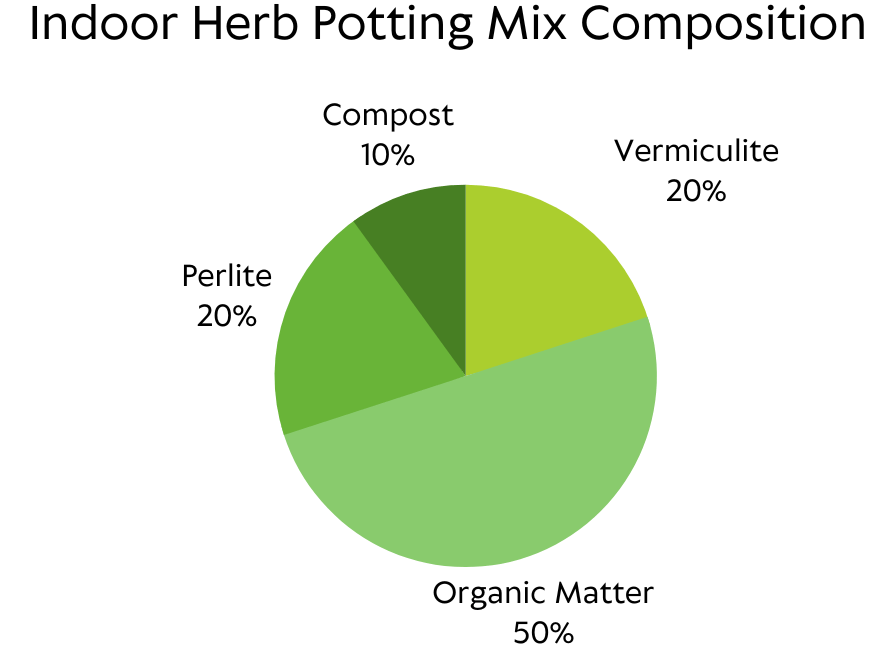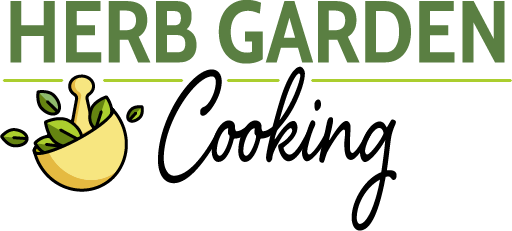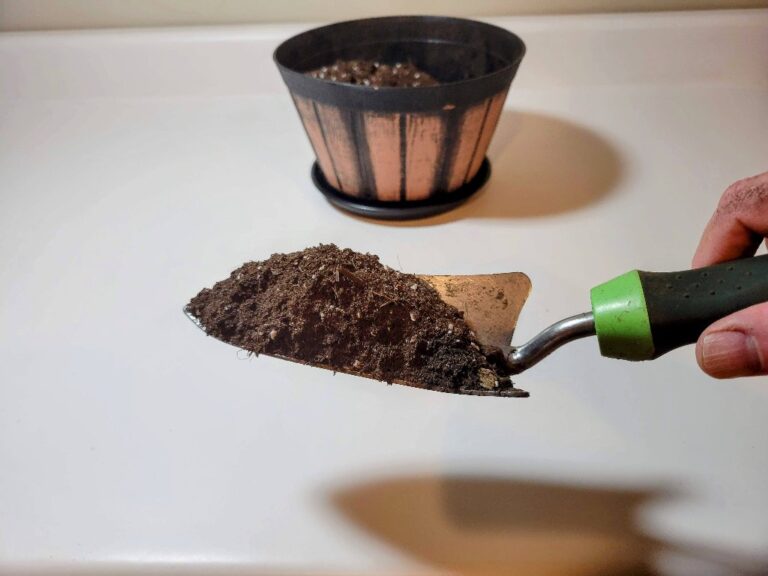This post may contain affiliate links which means I may receive a commission for purchases made through links. I only recommend products that I have personally used. As an Amazon Associate I earn from qualifying purchases. Learn more on my Private Policy page.
When cultivating herbs indoors, it’s crucial to recognize that their growth requirements differ from those when grown outdoors. A fundamental consideration is the choice of a suitable growing medium.
Indoor potting mix is better than garden soil for growing herbs indoors. It offers excellent drainage, moisture retention, and root aeration. Indoor potting mixes often contain peat moss, bark, perlite, and vermiculite. Consider mixing in cactus potting mix for drought-resistant herbs such as thyme and rosemary.
Let’s dig deeper into why indoor potting mix is the best choice, what makes a good one, and how to choose the best one for your indoor herb garden.
Table of Contents
Use Indoor Potting Mix for Growing Herbs Inside
Indoor potting mixes are custom-made with indoor container gardening in mind, as the unique demands of growing herbs indoors differ significantly from outdoor gardening.
Why Garden Soil Falls Short for Indoor Herbs
Garden soils are primarily intended for in-ground use and are rich in organic matter. They are not well-suited for indoor herb gardening because they tend to become compacted when wet. This waterlogging can prevent your herbs’ roots from breathing properly, resulting in stunted plant growth and other problems.
Critical Qualities of Potting Mix for Thriving Herbs
When cultivating herbs indoors, potting mixes stand out due to their distinct features:
- Well-Draining: Indoor potting mixes are formulated to provide excellent drainage. This is critical for potted plants to prevent compaction and too much water retention, which can lead to root rot.
- Aeration: Potting mixes are typically designed to be light and airy to provide sufficient aeration to root systems so they can breathe adequately. Lack of aeration can cause root suffocation.
- Optimal Water Retention: Potting mixes balance drainage and water retention, thanks to materials like peat moss and vermiculite, which help keep herbs adequately hydrated and prevent drought stress.
- Sufficient Nutrients: Amendments such as earthworm castings, alfalfa or kelp meal, and humus-rich materials such as compost add nutrients to indoor potting mix to ensure your herbs have the food they need to thrive.
- Lightweight: Potting mix is generally much less dense than garden soil, making it an ideal medium for container gardening. Its lightweight nature makes it easier to move around and reposition your indoor herb pots as needed.
Composition of Indoor Potting Mixes
Whether choosing store-bought potting mixes or making your own, it’s important to know what goes into making an ideal potting mix for indoor herb gardening.
Generally speaking, indoor potting mixes combine organic materials for structure and nutrients with inorganic elements for improved drainage, aeration, and water retention. Additional amendments are sometimes added as fertilizers, for pH control, or for specific nutrient availability.

Organic Matter in Indoor Potting Mix
The purpose of organic material in indoor potting soil is to provide structure and nutrients to the growing medium. Organic materials in potting mixes typically include one or more of the following:
- Peat Moss: Helps to retain moisture and provides aeration to the growing medium.
- Compost: Composted leaves, kitchen scraps, or manure can add nutrients and improve the overall structure of the potting mix.
- Coco Coir: A more sustainable alternative to peat moss, it also retains moisture and helps to provide aeration.
- Bark or Wood Chips: Pine bark is most commonly used to provide drainage and aeration in potting mix. Fir and cypress bark and chips can also be used.
Inorganic Materials Improve Drainage, Water Retention & Aeration
A variety of inorganic materials are used to enhance different aspects of indoor growing media, such as water retention, drainage, and aeration
- Perlite: Derived from volcanic glass, this white, granular material is known for its lightweight and porous qualities, enhancing drainage and aeration in potting mix.
- Vermiculite: A naturally occurring mineral that expands when heated, resembling tiny accordion-like flakes. It is lightweight and aids water retention in potting mix.
- Sand: Used for improving drainage, especially in succulent and drought-tolerant potting mixes.
- Pumice: A porous igneous rock that forms during volcanic eruptions due to rapid cooling and depressurization. It enhances soil structure, prevents compaction, improves aeration, and aids drainage.
Other Potting Soil Amendments
Some potting mixes may also include pH adjusters such as limestone or sulfur, as well as non-organic fertilizers. If you’re growing herbs organically, you’ll want to avoid using growing mediums that contain inorganic fertilizers.
Choosing Off-the-Shelf Potting Mixes for Indoor Herbs
With a vast selection of potting mixes on the market, where should you start in selecting the right one for your indoor herb garden?

I stick with organic potting mixes, and I have had good success with all 3 of the following commercially available varieties. I’m particularly partial to Back to the Roots Potting-Mix, as it is the “greenest” of the three options, which is why it tops my list:
Back to the Roots All-Purpose Potting Mix (Amazon): This all-purpose indoor potting soil has great moisture retention and is rich in nutrients, making it great for indoor herb gardening. It is a peat-free potting mix, making it a more environmentally sustainable option than other potting mix varieties containing peat, an important carbon store.
Espoma Organic Potting Soil Mix (Amazon): Formulated from regional organic materials, this is another excellent option for growing indoor herbs. It contains a proprietary blend of naturally occurring beneficial fungi that promote plant growth and water retention.
FoxFarm Ocean Forest Potting Soil Mix (Amazon): This is a popular potting mix in the organic gardening community and deserves a spot on my list. It has a light, airy texture and is rich in organic matter, as it’s formulated with earthworm castings as well as fish and crab meal.
Making Your Own Indoor Herb Potting Mix
Should you have an adventurous spirit, or if you simply want the ability to tweak it to perfection, you can also make your own potting mix.
Don’t hesitate to explore different combinations for your homemade indoor herb potting mix, but feel free to use the ratios below as a starting point.

- 50% Organic Matter: Roughly half of your potting mix should consist of a high-quality organic material such as peat moss or coconut coir. Note that coconut coir is a more environmentally friendly option than peat moss, as harvesting peat moss can destroy native habitats and release carbon, contributing to global warming.
- Consider incorporating pine bark nugget fines into your organic material for improved drainage. If utilized, the bark should make up a quarter to a third of the total organic material in your potting mix.
- 20% Perlite: Enhancing drainage and aeration.
- 20% Vermiculite: Provides moisture control and helps to reduce compaction.
- 10% Compost: Adds nutrients to the planting mix. Use high-quality store-bought compost or well-aged yard debris or kitchen scrap compost for best results.
Feel free to amend your potting mix with small amounts of slow-release plant food or organic fertilizers, but be careful not to overdo it.
While container-grown herbs require a bit more fertilizer than those grown in the garden, herbs are not heavy feeders, and too much fertilizer can damage your herbs.
Herb-Specific Potting Mix Guidelines
Whether using store-bought potting mix or making your own, it can often make sense to amend your potting mix to better meet the needs of specific herbs.
Herbs have different growing requirements and preferences. This is particularly true when it comes to the growing medium they are rooted into and feeding from. If desired, you can fine-tune your potting mix for specific herbs to ensure they are growing in optimal conditions.
| Herb | Texture | Nutrient Level | pH Level |
|---|---|---|---|
| Basil | Loamy | Moderate to High | 5.5-7.0 |
| Cilantro | Loamy | Moderate | 6.0-7.0 |
| Dill | Loamy | Low to Moderate | 5.5-6.5 |
| Parsley | Loamy | Moderate to High | 5.5-6.5 |
| Oregano | Sandy, Loamy | Low to Moderate | 6.0-8.0 |
| Rosemary | Sandy, Rocky | Low | 5.5-6.5 |
| Sage | Sandy, Loamy | Low to Moderate | 5.5-7.0 |
| Thyme | Sandy, Loamy | Low to Moderate | 5.5-7.5 |
Amending Potting Mix to Improve Drainage
Out of the three herb preferences I describe here, this is the one I prioritize the most. Moreover, it’s the most straightforward to integrate into my herb cultivation practices since it applies to various herbs I cultivate.
While moisture-loving herbs such as basil, parsley, cilantro, and parsley are typically content with the loamy texture of most indoor potting mixes, drought-tolerant herbs may perform better with minor tweaks to their growing medium.
Herbs such as rosemary, sage, thyme, and oregano are drought-tolerant herbs that prefer drier conditions and very well-drained growing medium. For this reason, I generally amend my indoor potting mix for these herbs with a coarse, sandy cactus or succulent potting mix to improve drainage.
Some good cactus and succulent potting soils I’ve had success with include:
- Espoma Organic Cactus Potting Soil Mix (Amazon)
- Hoffman Organic Cactus and Succulent Soil Mix (Amazon)
For rosemary and thyme, I typically mix in 1 part cactus potting mix to two parts standard potting mix. For sage and oregano, I reduce the cactus potting mix to about one-quarter of the total volume.
Adjusting for Nutrient Preferences
While herbs are generally not considered heavy feeders, some herbs have higher nutrient demands than others. Basil and parsley in particular are considered some of the heavier-feeding herbs. To accommodate their feeding needs, consider increasing amending the potting soil for these herbs with additional compost or fertilizer.
Adjusting pH
While some gardeners fine-tune their potting mix pH for individual herb preferences, I don’t spend much time on this. None, actually. If it’s something you’re keen on pursuing, pH testing equipment is available. You can also adjust your potting mix pH by incorporating materials such as limestone to raise the pH if your mix is too acidic or sulfur to lower the pH if your mix is too alkaline for your needs.
Conclusion
When cultivating herbs indoors, opt for indoor potting mix over garden soil. Its superior drainage, aeration, and moisture retention cater to the unique requirements of indoor container gardening. Whether choosing store-bought options or making your own, understanding your growing medium’s composition and adjusting it for specific herbs ensures a thriving indoor herb garden.
Last Updated on 24 April 2024 by Bob Lee

